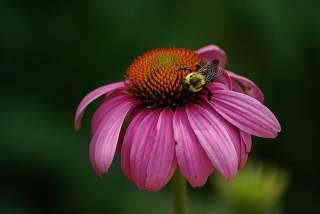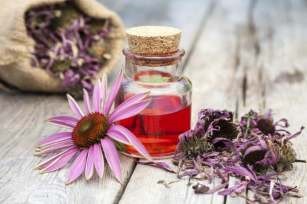Echinacea
 Common Names: Eastern purple, coneflower, furple coneflower, hedgehog coneflower, or echinacea
Common Names: Eastern purple, coneflower, furple coneflower, hedgehog coneflower, or echinacea
Scientific Name: Echinacea purpurea
Climate: Temperate and subtropical
Plant description: A one-meter tall perennial herbaceous plant. Characterized by a hairy, hollow, thin yet resistant and pubescent stem and leathery, oval or lance-shaped leaves. The leaves are olive green with serrated margins and a short-winged petiole. The flowers are peripheral with tight ligules. Each flower has 10-20 drooping rays of purple or pink. The flowers surround a robust spiny orange cone made of many disk florets. Echinacea roots are fibrous and form small colonies from short, thick rhizomes.
Original to North America
Cultivation: Full sun. The plant prefers clayey or sandy soils that are well drained and retain adequate humidity. It adapts to alkaline, and gravel soils. Once established it also tolerates drought.
To obtain healthy plants it is recommended to put in the soil the high amount of organic fertilizer or animal manure.
It can be multiplied by seeds, transplants, cuttings, root cuts and basal cuts.
Echinacea is easy to grow from seed. But the crop will not produce a lot. If you decide to grow from seed, choose a humid and sunny place with room to grow. It is sown 1.25 centimeters deep during the time when there is still a little frost. There is no need to cover the seeds with soil. It is only lightly pressed and watered to keep it moist but not too wet. The seeds germinate in 10-20 days and it is when the first leaves of the new plants will begin to appear. Those first leaves will be a sign that the seeds are germinating. The flowers bloom reliably the first year. Echinacea easily self-seeds and will spread wherever you leave it.
Propagation by transplants has better results than other forms of reproduction. For this technique it is recommended that the seeds be started in containers in a greenhouse or other protected place and then transplanted into the field. Before sowing, pre-germination treatment is needed. Dried seeds are stored for several weeks before starting pre-germination techniques.
Echinacea germinates easily, but germination rates improve by giving the seeds a cool, wet layering of one to four weeks in peat moss or sand at a temperature between 0 ° C. at 5 ° C. Then it is sown in containers or seedbeds in a greenhouse. It is allowed to germinate for 20 - 30 days. When you see the first leaves that means the seeds are germinating. When new plants are large enough, move echinacea plants while taking care not to damage the roots and plant them individually or in small groups.
Propagation by root: A night before removal of the cutting, the mother plant must be watered to a depth of 5 cm, so that the roots will be hydrated and moist. A container with rooting hormone is prepared.Another container (with a hole underneath) of about 8 cm must be filled with 3 parts of coarse sand and 2 parts of ground peat. It is filled with water and allowed to drain for 20 to 30 minutes before putting on echinacea cuttings.
Dig gently around the outer edges of the plant until the roots are seen. At this time water is poured over the roots to rinse the soil. Locate a root 2-4 cm long with a thick, healthy shoot that grows from the top. Cut the root with a clean, sharp knife. Trim the stems to 6 cm with clean garden scissors. Fill the hole left by the root with soil to protect the mother plant. Take a container with moistened sand mixture and make a deep holein it. The root is inserted into the planting hole so that the base of the stem is at the level of the surface. Fill with the soil around the root. The pot is placed in a protected and slightly shaded area, such as inside a cold frame or outdoors on a porch. Protect the pot from direct sun and extreme temperature fluctuations. Keep the sand mix slightly moist. The top of the soil should be allowed to dry slightly between waterings to decrease the likelihood of rot or fungal infections. Three weeks later echinacea cutting is transplanted into a 12-15 cm pot filled with potting soil.
Grow echinacea under light shade by watering once a week. Acclimatize to direct sunlight in 2-3 weeks. Move the cuttings to a sunny bed with clayey and fast-draining soil in autumn, planting them 30-100 cm of the distance.
Pinch the older flowers regularly to extend the flowering period. Apply a quality flower fertilizer several times during the gardening season to promote large and beautiful flowers. Mulch to prevent weeds.
The plant takes two years to flower. Do not harvest anything until the flowers have bloomed at least 1 time, and then wait for them to bloom again to harvest them. This will help ensure that the plant is strong enough to withstand harvest and that it has an established root system. The flower is harvested before it begins to fade by cutting with a sharp scissor just above a node. To harvest the roots you have to wait for the plant to be at least 3 years old. A garden shovel is inserted into the ground about 0.50 - 0.61 m from the base of the echinacea. Then, the shovel is pressed with the foot and the plant is lifted by the roots. This will help ensure not to go too deep into the roots. A trench can also be dug around the plant to loosen the soil and the root. Take care not to dig too close to avoid damaging the roots.
Uses: Echinacea has a positive impact on health by reducing inflammation, improving immunity, and lowering blood sugar levels. In Native American Indian medicine, the plant is used externally for wounds caused by insects, burns and stings; the roots are chewed to alleviate toothaches and to fight against throat infections. The internal application is used for coughs, stomach cramps and snake bites. In many countries it is used in the treatment of upper respiratory tract infections including colds.
It is important to avoid it if a person takes immuno-suppressants, or if a person has had nausea or some type of stomach upset after consumption.
Plagues and diseases: No major pests have been reported. Minor pests include leafhoppers, gopheras, grasshoppers, and a nematode.
The major echinacea diseases and pests are: stem rot (caused by Rhizoctonia spp. or Athelia rolfsii), powdery mildew, anthracnose, and aster yellows, as well as damage by aphids, Japanese beetles, and eriophyid mites. But the symptoms and the result are usually mild. Cultural practices, such as proper plant spacing and well-drained soils, and proper sanitation through removal of plant debris will help reduce disease problems.
Powdery mildew can be prevented by maintaining optimal plant health and not crowding at planting.
References:
http://www.newmoonnursery.com/plant/Echinacea-purpurea
https://www.mtnativeplants.org/wp-content/uploads/2018/07/KR-2010-Growing-Echinacea.pdf
En español: Equinácea

